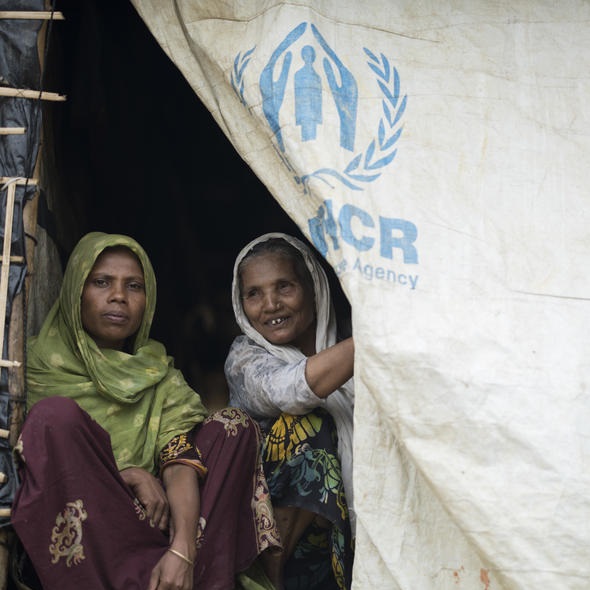Evaluation of Community-Based Protection and Solutions Programme in Priority Areas of Return and Re-integration in Afghanistan, Household Survey - March 2021
Afghanistan, 2021
Get MicrodataIdentification
UNHCR_AFG_2021_PARR_March_HH_v2.1
Evaluation of Community-Based Protection and Solutions Programme in Priority Areas of Return and Re-integration in Afghanistan, Household Survey - March 2021
| Name | Country code |
|---|---|
| Afghanistan | AFG |
Other Household Survey [hh/oth]
Following the influx of refugee-returnees from Pakistan and Iran in 2016, UNHCR has been supporting the Government of the Islamic Republic of Afghanistan's (GoIRA) Ministry of Refugees and Repatriation (MoRR) through a series of programmes aimed at providing durable solutions for returnees and long-term displaced populations in Afghanistan. 20 locations were identified by UNHCR and GoIRA as Priority Areas of Return and Reintegration (PARR locations). In these locations, large populations of refugee-returnees, internally displaced persons (IDPs) and host communities live together. Within these PARR locations, UNHCR implemented its short and medium-term Community-based Protection and Solutions Programme Response (CO-PROSPER) programmes to promote long-term development initiatives. UNHCR aimed to develop an area-based, humanitarian-development-peace triple nexus response to support durable solutions and create conducive conditions for the sustainable reintegration of displaced persons.
To understand the impact of these programmes on the PARR locations, IMPACT Initiatives (IMPACT) conducted an evaluation of the impact of the programmes in PARR locations across four different dimensions: 1) community leadership inclusivity, 2) strengthening public services and equitable access, 3) income generation and economic empowerment, and 4) peacebuilding, and created indices to measure progress over these four key objectives that can be compared against the programme goals.
In order to conduct this assessment, a mixed-method approach was used with two structured tools with separate methodologies to assess each site as follows.
A HH level tool was used to interview a representative sample of HHs in each of the 20 PARR locations, with a 95% confidence level and a 10% margin of error. While aggregated (to the overall HH level) results are representative by population group (IDPs, refugee-returnees, and host communities) and by location, findings per population group in the locations are indicative only.
Household data collection took place from 20 February to 4 March 2021. A total of 2,039 households in representing a total population of 1,347,207 people (approximately 192,458 households) across 20 PARR locations were interviewed.
Sample survey data [ssd]
Households
Version
v2.1: Edited, cleaned and anonymised data
2022-05-30
Scope
The scope includes:
- displacement status
- displacement intentions
- local community structures
- Women's Empowerment
- conflict resolution mechanisms
- Employment and Livelihoods Opportunities
- Cooperatives
- Education
- Access to health
- Protecion
- Shelter (housing, land and property)
- PARR Impact
| Topic |
|---|
| Health and Nutrition |
| Protection |
| Community Services |
| Livelihood and Social cohesion |
| Peace Building/Conflict Prevention Sector |
| Income Generation |
Coverage
Shash Pool and Qashqa, Nilli, Tarakhail Daag, Ghaziabad, Aka Khail Area, Laghmani, Qala-e-Nasro & Bini Warsak, Majboorabad, Charbagh, Daman, Shekh Mesri, Aziz Khan Kas, Noor Abad, Sakhi Camp & Qalin Bafan, Sher Khan Bandar, Loya Wala, Mirwais Mina, Kahdistan, Jebrial
Identified key informants representing targeted population groups
Producers and sponsors
| Name |
|---|
| UNHCR |
| IMPACT |
Sampling
The assessment was implemented through a simple random sampling approach as a site-level household representative survey that was statistically representative at site level for each of the 20 PARR locations.
In coordination with UNHCR and its partners, IMPACT developed a set of key indicators through which to conduct a Socioeconomic Vulnerability Assessment (SEVA) of household conditions across four key indices: 1) Community Leadership Inclusivity, 2) Service Quality and Access, 3) Livelihoods and Economic Outlook, and 4) Community Relations and Stability, as well as Key Vulnerability metrics.
These were administered as a household tool by trained enumerators to a random sample of households in each PARR location. Findings are statistically representative with a 95% confidence level and 10% margin of error for each of the 20 assessed PARR locations. at an aggregated level, findings are statistically representative with a 95% confidence level and a 5% margin of error for each population group, as well as the entire sample, at an aggregated level, without disaggregating by site.
Sampling at site level: To sample at site level, enumerators started at the edge of the PARR location, and walked towards the centre, skipping a fixed number of households based on the population between interviews as the went. When they reached the middle of the PARR location, then would then turn around and travel back to their starting point, skipping the same number of households as they went. Population data used for the sampling frames came from UNHCR's Reintegration and Partnerships Unit.
Only respondents above the age of 18, who either were the head o the household or could reasonably speak for them, were interviewed. Enumerators teams included both men and women to ensure that women could be interviewed, ensuring female voices in the data. In total, 25% of respondents were female.
Analysis: Data was weighted and analyzed by site population. For key indices to measure the four indices for reintegration, and the vulnerability metrics, composite indicators to weight responses based on their severity were created and validated by IMPACT's Global office in Geneva and UNHCR in Kabul.
Data collection
| Start | End |
|---|---|
| 2021-02-20 | 2021-03-04 |
| Name |
|---|
| IMPACT |
Data Access
UNHCR, IMPACT (2021). Afghanistan: Evaluation of Community-Based Protection and Solutions Programme in Priority Areas of Return and Re-integration in Afghanistan, Household Survey - March 2021. Accessed from: https://microdata.unhcr.org
Contacts
| Name | Affiliation | |
|---|---|---|
| Curation team | UNHCR | microdata@unhcr.org |
Metadata production
UNHCR_AFG_2021_PARR_March_HH_v2.1
| Name |
|---|
| UNHCR |
2022-06-08
